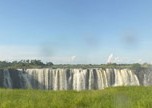The harbor of Rio de Janeiro, also called the Guanabara Bay, is a place of astounding natural beauty. It is a natural harbor set in a balloon shaped bay that extends approximately 20 miles inland. It has a backdrop of strangely shaped mountains and rainforests. It has 130 islands and is home to some great beaches.
Charles Darwin visited the place in 1932 and while describing the place he wrote that it seemed almost unreal. True to that description, the harbor looks very different depending on the place from where you look at it. Earliest explorers first thought that it was the mouth of a large river. From some angles it looks like a lake when in reality it is a huge bay. It is, therefore, not surprising that it found a place on the list of the Seven Wonders of the Natural World.
Geographic Features and Formation
The harbor, which consists of the bay and the surrounding mountains, has a bare granite peak that is about 1,300 feet tall. It is called Sugarloaf, a name given by the Portuguese explorers who felt that it resembled a conical sugar loaf in shape. The highest mountain in the harbor is called the Corcovado, which means hunchback. It is 2,300 feet high. The surrounding mountains and rainforest have higher peaks, with the Tijuca peak at 3,350 feet tall being the most famous. The 130 islands that dot the bay are actually peaks of smaller underwater hills. Governor’s island, Snakes Island and Fundao are some of the famous islands in the bay.
The hills and mountains are part of a range called the Serra do Mar that is 1,500 miles long. The range meets the sea at this place. The harbor and its features are the result of erosion of these mountains by the Atlantic Ocean. The mountains are made up of hard granite and soft gneiss rocks. Over the centuries, the waves from the ocean, wind and rain eroded away the exposed gneiss rocks much more than the harder granite. This eroding caused by the elements over time created cliffs and valleys which give the hills and mountains their peculiar shapes. The erosion is an ongoing process to this day.
Discovery
Portuguese explorers led by Goncalo Coelho discovered the harbor on January 1st, 1502. The fleet of three ships had earlier arrived on the Brazilian coast in August of 1501. The harbor was discovered as they were trying to map the shoreline of the South American continent.
On New Year ’s Day in 1502, they reached what they thought was the mouth of a huge river. They were captivated by the strangely shaped, but beautiful mountains. They named the place Rio de Janeiro which literally translated means January River.
The area was later colonized by the French and Portuguese. The Portuguese evicted the French and the city of Rio de Janeiro as we know it now came into being. Rio was the capital of Brazil for a number of years before the capital was changed to Brasilia.
The Rio de Janeiro harbor is truly a spellbinding place with its wonderfully shaped mountains, rainforests and great beaches. September and October are the best months to visit the place as the weather is nice and comfortable.







